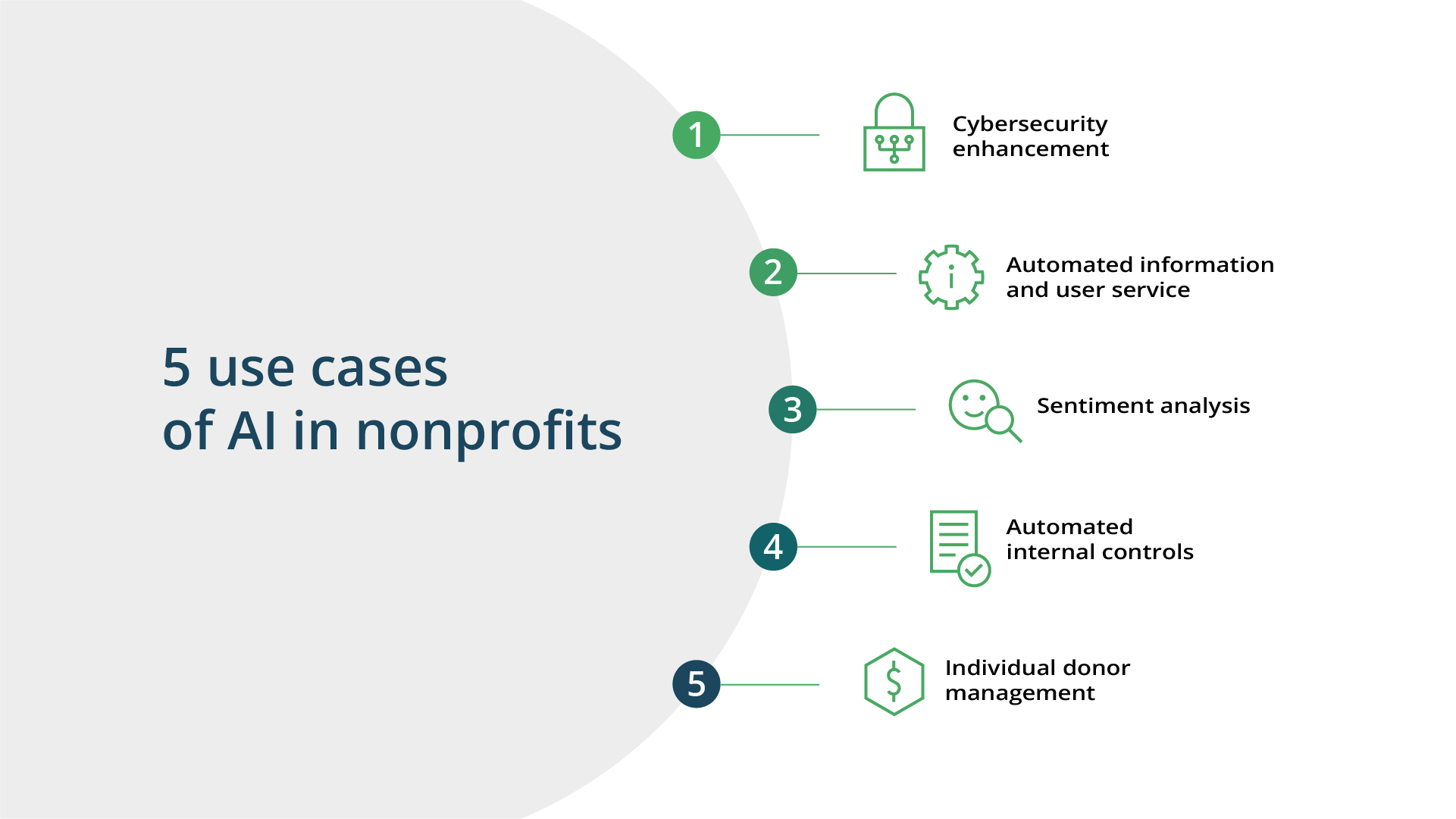Transforming Nonprofit Work with Innovative Smart Technology and Enhanced Automation Practices

Similar to other industries, technology is becoming increasingly prevalent in nonprofit organizations. Fundraising, political, and charitable organizations leverage smart tech to carry out their missions more efficiently than ever before.
With a growing interest in artificial intelligence, machine learning, and data analysis among nonprofits, many organizations are starting to apply these new technologies in managing such fields as finance, human resources, communications, internal operations, and sustainability.
In this article, we’ll define smart technology for nonprofits and observe use cases and real-life examples of its implementation in the nonprofit sector.
What is smart technology?
‘Smart tech’ is a general term that denotes a variety of cutting-edge digital technologies capable of making decisions on behalf of people.
This implies artificial intelligence (AI) and its subfields, such as Machine Learning, Natural Language Processing (NLP), chatbots, intelligent forms, robots, and various others.
The benefits of smart tech for nonprofits
A recent report by the AI in Advancement Advisory Council found that about 90% of nonprofit professionals are optimistic about the role of AI in their work. By automating tedious tasks, AI and other intelligent technologies can free staff to focus on more value-added and “people-centric” tasks.
Here are some more benefits of smart tech for nonprofit organizations.
Managing larger amounts of data
Integrating artificial intelligence technology into the nonprofit sector enhances the ability to process and comprehend large amounts of data. This tool facilitates the identification of various user profiles, enabling a more in-depth understanding of their needs. As a result, interactions with donors and collaborators become more personalized, contributing to their satisfaction and informed decision-making.
Error reduction
By automating tasks that were previously done manually, AI reduces the chances of human errors.
Not only does it reduce errors, but it optimizes the allocation of staff’s time to more productive work.
Customization
AI platforms for nonprofits enable highly specific audience segmentation, which implies geographic, demographic, and sentiment data analysis. This preciseness facilitates the generation of personalized messages that efficiently engage users based on their individual preferences and behaviors.
5 use cases of AI in nonprofits
Below we’ll observe five use cases of smart technology, namely artificial intelligence, in enhancing nonprofit companies’ operations.
1. Cybersecurity enhancement
AI can help nonprofits defend against cybercrime. This can be done by:
- automating network monitoring to identify abnormal behavior in organizations’ databases
- examining what normal behavior looks like
By managing these tasks, AI can help detect and prevent cyber attacks, even if an organization does not have the resources to maintain a dedicated security team.
2. Automated information and user service
Nonprofits can also automate their email and customer service processes with the help of AI by:
- automating drafting and sending emails to free up valuable time
- applying generative AI models that use templates for information materials and then personalize messages for each user
- automating customer service via chatbots, which respond to inquiries 24/7 and respond faster than humans
3. Sentiment analysis
Nonprofits can use AI to analyze public sentiment about their organization by:
- scanning social media and other web postings
- analyzing text to determine the emotions it represents, such as anger, frustration, or support, via NLP tools
These insights can help organizations identify if their initiatives meet expectations or need improvement.
4. Automated internal controls
Nonprofits have many mundane, data-intensive tasks that AI can automate, freeing up time for more strategic work.
AI can simplify three critical internal controls:
- management of duties by separating them and monitoring employees to prevent fraud
- transaction authorization, including notification of authorities when someone requests a transaction
- documentation control by recording and formatting every transaction for more streamlined and transparent documentation
5. Individual donor management
AI is commonly used in fundraising and donor management for nonprofits.
For instance, ML algorithms can do the following:
- analyze donor database information and data from various sources to gain insights about each donor
- create personalized and effective multi-touch campaigns to increase engagement and prevent donor churn based on the insights of the analysis
AI can identify the donors most likely to donate and help determine the best way to communicate with each individual. Nonprofits can use segmentation to recognize donors who are most likely to donate and find the best way to communicate with them. Yet, AI can take it further by providing insights into individual preferences.
Real-life examples of AI application in nonprofits
Now, let’s observe three real-life examples of implementing artificial intelligence, one of the subfields of smart tech, into the operations of nonprofits.
Greenpeace Australia Pacific enhanced their fundraising efforts via AI
Greenpeace AU has partnered with an AI tech vendor to enhance their fundraising efforts using artificial intelligence in 2 strategic ways:
- Direct mail donation appeals
- Reduction of churn in their regular giving program
The AI technology analyzed the charity’s fundraising history, interactions, and communications, assigning each donor a propensity score indicating their likelihood to donate through a direct mail appeal. This information created a targeted list of donors most likely to donate once an appeal is received.
The AI-generated list was compared to a list generated using traditional segmentation methods, and the campaign was carried out using both lists.
Greenpeace also used AI to reduce churn in their recurring donation program by assigning churn propensity scores to regular donors and flagging the highest-risk donors likely to miss three consecutive gifts in the following six months.
The result:
The results showed a significant difference in ROI between the two lists, with the AI-generated list performing much better.
The smart-tech initiative allowed Greenpeace to address regular donors with personal thanks and retain over 60 donors who would have otherwise ceased to donate, resulting in tens of thousands of dollars of savings for the organization.
Parkinson’s UK utilized AI-powered predictions to enhance its fundraising strategy
Parkinson’s UK also utilized AI-powered predictions to refine its fundraising strategy during its direct mail campaign.
The machine learning algorithm studied the organization’s historical fundraising data to create a targeted list of donors most likely to donate.
The result:
The results showed a higher response rate and more individual gifts than the traditional segmentation approach, resulting in a potential 23% increase in revenue when focusing on donors identified through machine learning.
Jacaranda Health has adopted advanced technology to reach a large number of beneficiaries
Jacaranda Health, a nonprofit based in Kenya, has adopted advanced technology to reach a larger number of beneficiaries.
The organization strives to eliminate preventable deaths of mothers and newborns in a country with one of the highest maternal mortality rates worldwide.
Jacaranda Health introduced an AI-driven healthcare platform that provides pregnant women with valuable information, potentially life-saving advice, and referrals to medical facilities for necessary care.
The platform employs AWS to operate a two-way AI-supported helpdesk that receives thousands of daily messages in both Swahili and English.
Utilizing NLP, the platform scans the messages for indications of medical emergencies and alerts Jacaranda Health’s medical agents at the helpdesk.
These agents possess medical training and can respond quickly to mothers and guide them to the nearest medical facility.
The result:
Currently, mothers utilizing this service are over 20% more likely to follow the recommended number of antenatal care visits (more than four), 3.5 times more likely to receive medical care if experiencing emergency signs after childbirth, and twice as likely to access the help of family planning.
To sum it up
In this article, we’ve defined smart technology for nonprofits, observed use cases, and real-life examples of leveraging it in the nonprofit sector.
Real-life examples of AI applications in nonprofits, such as Greenpeace Australia Pacific, Parkinson’s UK, and Jakandra Health, have demonstrated the effectiveness of the technology in enhancing fundraising and reducing churn.
As technology advances, nonprofits will likely embrace smart tech to achieve their missions more efficiently and effectively than ever before.
With 27+ years of background in custom software development and digital transformation, Kanda has extensive experience implementing smart technologies for various organizations, including nonprofits, and helping them effectively leverage these technologies to improve their operations and achieve their objectives.
By partnering with Kanda, nonprofits can use their resources to enhance their technological capabilities and achieve their mission more efficiently.
Talk to our experts to begin your journey to smart technology.
